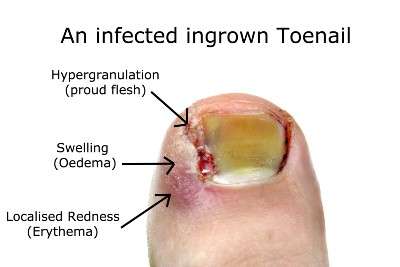Fix Ingrown Toenails [Updated 2024]
Fix Ingrown Toenails Now!
Obviously no-one likes having ingrown toenails for the following reasons:
- They cause a lot of pain – especially when you put them into shoes!
- They look unsightly – so you tend to want to hide the in shoes but… see above.
- They smell! – bacteria living in your ingrown toenail produce offensive odours.
- They can lead to more serious infections – especially if you have any compromise to your immune system or are diabetic.
In This Post I Will Discuss
The Hidden Risks
Ingrown toenails can be a lot more dangerous than you think.
That is because the pain that you feel from ingrown toenails and the pus that arises is due to bacteria living in the skin surrounding your toenail.
As long as this bacterial infection is short term and stays localised (just around the toe itself), there is usually no further problems.

If however, the infection goes on for longer or your immune system is in some way compromised, the bacteria can infect your lymph vessels or the bone of your toe.
Here are some of the reasons why you might be at a higher risk of more systemic infections:
- you are on medications such as steroids, or medications for arthritis, IBS, and other autoimmune conditions,
- chemotherapy (cancer treatments),
- lack of sleep or anxiety,
- lack of important vitamins such as vitamins C and D,
- you have Diabetes type 1 or 2.
If you have any of these conditions you should make sure that your doctor (GP and specialists) are aware of it.
Signs of a More Serious Infection
Some signs of further infection can be:
- A larger red area over the whole of your toe or on the top or bottom sides of your foot – see a doctor immediately,
- Red lines running from the toe up the foot or leg – get to a hospital immediately,
- Pain that significantly increases in the toe,
- Pain behind the knee or in the groin – see a doctor immediately,
- Pain in the calf muscles – get to a doctor immediately.
N.B. As you can see most of these signs are quite serious and require urgent attention.
Tips for Preventing Ingrown Toenails
So how can we avoid getting ingrown toenails in the first place? As we all know, protection is definitely better than the cure, right?
Here are our top tips:
- Cut your nails to follow the curve of your skin – more towards straight than curved. You don’t want either of the corners being below the skin,
- Do not allow your nails to get too long either, as a long nail is more prone to being broken by a sheet, a sock, a shopping trolley, a bed foot. When the nail breaks it always leaves a jagged edge – this is what breaks the skin and allows infection in.
- Avoid wearing shoes with a tight or pointy toe-box. The more your nails are squished, the more likely a piece will splinter and cause an ingrown toenail,
- Make sure that soccer boots and netball shoes have a good strong toe guard bulit on the outside of the shoe to prevent injury.
Tips for Fixing Ingrown Toenails
Above are some good ways of avoiding getting an ingrown toenail.
But sometimes you just get them anyway no matter how hard you try, so here are a few tips to help you to at least settle down the ingrown toenail:
- When you first feel the start of an ingrown, or if it is established you can perform a simple taping method which basically pulls the skin away from the offending nail. To the right is a great video by the guys at AC Podiatry.
- After your shower do a 5-8 minute soak in warm, very salty water.
You need about 3 palms of salt to a litre of water to make it hypertonic so that it will draw out fluid which reduces the swelling.
This will also reduce pain. - Straight after the soak, gently pat your foot dry with a clean towel and apply Betadine (Iodine) liquid to the area so that it gets down into all the cracks. Bacteria cannot live with iodine, so any of the surface bacteria should be killed.
- Whenever you are out of the house or wearing socks or in bed – dress the toe (after the Betadine) with a clean Band Aid or other plain dressing for at least 5 days.
- If you notice yellow, white, or brown pus, get in to see your Podiatrist to get the offending nail removed and the area drained.
Your Podiatrist may also recommend seeing your GP to get antibiotics if they are appropriate for you.
Your GP family doctor is the person who will decide if they’re appropriate.
How Podiatrists Fix Ingrown Toenails
Now for the best bit – Podiatrists can not only fix your ingrown nails in the short term, we can also fix them permanently!
They are the experts when it comes to fixing your ingrown toenails with both the skills and the tools to get the job done.
If your toenail is quite infected, the best thing to get it settled down quickly, is to see a podiatrist. We can treat the root cause of the problem.
Antibiotics will likely settle the problem for a while, but as long as the root cause is still there, the problem will return once the antibiotics are finished.
The root cause is a sharp or jagged part of your toenail which is breaking the skin of your toe and allowing bacteria to get in!
We use a tiny tool, which only Podiatrists use, which allows us to remove the piece of nail causing the problem, with very minimal pain – honestly!
The reason that the pain is minimal is that we are very experienced at treating ingrown nails and are able to remove the nail with very little movement of the nail or pressure on the skin around the nail.
It is the movement and the pressure that causes most of the pain you feel with an ingrown toenail.
Fixing Ingrown Toenails Permanently!
Probably the best bit in most people’s opinion.
With a mildly invasive surgical technique which requires no stitching, podiatrists are able to remove the ingrowing portion of your nail, and prevent it from ever growing again (in most cases).
In this procedure we use a local anaesthetic to numb your toe, then perform the procedure of removal and chemical cautery.
Most people are good candidates for this procedure.
If you have diabetes, peripheral neuropathy, or peripheral vascular disease or are on blood thinning medications, talk to your podiatrist to see if you are eligible.
To find out more on this awesome surgical procedure check out my earlier blog post here.
If you’d like help with your ingrown toenail in the short or long term you can call and make an appointment online by clickling below, or phone 3351 8878.
Thank you for reading this post!

Disclaimer
The advice on this page and the website dynamicpodiatry.com.au is general in nature and should not be considered as medical advice, but for informational and educational purposes only.
Although we are podiatrists, unless you are a patient of our clinic and have been given the advice directly, it may not be suitable for you.
Please consult your podiatrist or medical practitioner before taking on any of the advice given.

